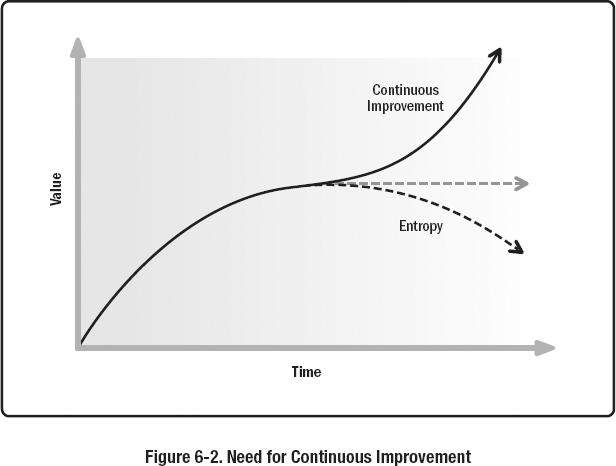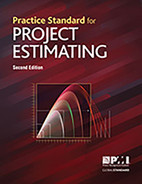6
IMPROVE ESTIMATING PROCESS
The purpose of the Improve Estimating process is to improve the organization's estimating capability for the OPM components. This section includes the following subsections:
6.2 Assess the Estimating Process
6.3 Implement Changes and Share Lessons Learned
6.1 OVERVIEW
A key objective of the Improve Estimating process is to update the organizational process assets, especially but not limited to, the estimating processes, templates, tools, and other assets. The process is based on actual data and lessons learned and completes the cycle by communicating process updates and assuring consistent process use.
This activity incorporates, but is not limited to, lessons learned and empirical data to calibrate the models, processes, and results in more accurate estimates. Improvements should be identified and applied at any point in the program or project life cycle.
Businesses apply process improvement techniques, such as process reengineering, to operations to improve efficiency and effectiveness. These same techniques apply to improving the efficiency and effectiveness of the estimating process regardless of the method or technique applied. One technique is demonstrated in Figure 6-1 and includes standardizing, measuring, controlling, and improving.

Continued realization of process application benefits is dependent upon the stewardship of the governance function in the organization. Choosing the best methodology for the improvement approach depends on the organization's structure, size, and complexity.
Studies show that most organizations that do not pursue continued improvement will regress and lose the value previously attained. For that reason, it is important to ensure that the estimation policy outlines a continuous improvement process. As indicated in Figure 6-2, there is a point where the actions that an organization takes will either progress with continuous improvement on the upward curve or regress to a less-than-desirable level of competency, as indicated in the downward curve.

Managing and monitoring of the results of estimating process improvement actions are important to ensure that the levels of performance demanded have been achieved and to ensure that no unintended negative outcomes have resulted from the change. Figure 6-3 illustrates a long-term concept for overall process management methodology monitoring and management. Organizations plan and put in place the structure to perform this monitoring and improvement to ensure that the process management system continues to provide value and benefits to the organization. These benefits can be optimized on a long-term basis.

6.2 ASSESS THE ESTIMATING PROCESS
To improve the estimating process, the team needs to gather the relevant information and plan for the improvement.
The example shown in Table 6-1 shows key questions that can be used to develop the estimating process improvement plan.

The estimates are analyzed to identify opportunities for improvement once the necessary inputs are gathered. The assessment will determine whether the estimating process performs and meets the portfolio, program, project, or organizational unit-specific demands. It will also examine the process steps, context, and the assets, tools, and techniques utilized to formulate the estimate.
The findings of this analysis will be discussed in work sessions to determine their root causes. Root causes are identified by using techniques such as brainstorming, the 5 Whys, or the fishbone diagram. It is also valuable to staff these sessions with people who have problem-solving skills. An action plan for corrective or preventive actions needs to be developed to remedy the problems found in the current program or project.
The results of the analysis can also be used to update:
◆Organizational process assets such as the organizational lessons learned to be shared with future programs and projects or future iterations of the ongoing project.
◆Tools and techniques used in the estimating process, for example, historical information for analogous estimating, calibrated parametric models, and templates.
6.2.1 INPUTS TO THE IMPROVE ESTIMATING PROCESS
The following inputs assure success of the Improve Estimating process:
◆ Program and project information. The current program or project assets and results are assessed in search of improvement opportunities that can benefit current and future portfolios, programs, projects, or iterations. Project scope, risks, current estimates, and their assumptions are some of the objects of improvement opportunities.
◆ Project estimating approach. The current project estimating approach is the output of the Prepare to Estimate stage described in Section 3. Here it is used as an input.
◆ Historical program and project information. Historical program and project information is information collected from similar completed programs and projects and is described in Section 3.
◆ Baseline estimates. A baseline estimate is the first deliberate, detailed estimate of the effort, resources, cost, and schedule and is described in Section 4.
◆ Updated estimates/forecasts. Updated estimates/forecasts are estimates that have been made after the baseline and are described in Section 5.
◆ Logs and registers. Any project asset used to track and capture modifications, assumptions, and constraints within a portfolio, program, or project that suggests opportunities for process improvement.
◆ Work performance data. Planned versus actual estimate data include performance data for scope, schedule, resource measurement, and other elements expended on a program or project through a specific period.
◆ Lessons learned. Collecting and documenting lessons learned is a critical means of transferring knowledge to other programs, projects, or iterations. Lessons learned are generally collected at the end of a program, project, iteration, or after a critical activity or milestone. For adaptive life cycles, lessons learned are often captured during retrospectives often scheduled on a regular basis or conducted when a body of work is completed, such as the conclusion of an iteration or at the end of a project phase. To apply these lessons learned, it is essential that the information be easily accessible and institutionalized into the governing organization and its processes and procedures.
◆ Organizational process assets. Examples of organizational process assets are the established measure, model, definition, or criterion against which the estimating process is measured and are described in Section 5.
6.2.2 OUTPUTS OF THE IMPROVE ESTIMATING PROCESS
Many outputs from this process can be captured and applied not just to the current efforts but with future efforts in mind, for example:
◆ Estimating process improvement action plan. Having a great idea or a lesson learned from a retrospective is only as good as the actions generated. An action plan is a document—resumed or ample, simple or complex—depending on the organization's size and complexity, organizational change readiness, and estimation process change demands. The plan defines which identified improvement opportunities to implement and which to defer. This decision is based on change demands, cost, timing, change readiness, and resource availability. The plan should point to critical success factors; interdependencies such as logical, vertical, and horizontal; and prioritized improvement opportunities based on criteria such as interdependencies, value, assumptions, and constraints.
In addition to the technical changes, at a minimum, the action plan should include organizational change management aspects such as stakeholder engagement and mobilization, communication, coaching and training, and measurements of the proposed improvement results and impacts.
◆ Organizational process assets update proposals. Generally, the assets are not updated as part of the project work. Processes, policies, and procedures are typically established by the project management office (PMO) or another function outside of the project.
Where valuable, an organizational process assets update proposal should describe the identified estimation process inefficiency or failure, the identified causes, and the steps needed to improve the asset or its use.
6.3 IMPLEMENT CHANGES AND SHARE LESSONS LEARNED
Once the estimation process has been assessed and actions identified, the organization and project manager implement those changes and validate the associated metrics and measures.
6.3.1 INPUTS
Inputs to the Implement Changes and Share Lessons Learned process are:
◆Estimating process improvement actions plan, and
◆Organizational process assets update proposals.
6.3.2 OUTPUTS
Outputs to the Implement Changes and Share Lessons Learned process are:
◆ Updated organizational process assets. Updates to the organizational process assets can include, but are not limited to the following:
■ Update to any artifact that defines the standard for estimating or affects the estimating process,
■ Update to the estimating approach document, and
■ Documentation of lessons learned for use in future projects.
◆ Final report. The final report can be resumed or ample, depending on the organization's size, complexity, culture, and improvement scope.
The final report documents the improvement by: consolidating assessment findings, updating proposals, results from test and update evaluations, implementation performance documented using key performance indicators (KPIs) or other means, and an integrated estimation review. This report can point to additional improvement opportunities.
6.4 CONSIDERATIONS
Considerations for the Implement Changes and Share Lessons Learned process are:
◆ Senior management support. Process updates need senior management support. The appropriate authority needs to be delegated to the practitioners who will be implementing the changes.
◆ Investing the appropriate time and effort. Investing the time and effort in search of improvements during the project life cycle is recommended. Preventive or corrective actions could positively impact current or future activities within the program, project, or future iterations, and the overall estimating process for the organization.
◆ Consider the skill set. It is important to note that the skill set needed to facilitate problem-solving sessions for determining the root causes may require resources not assigned to the current project. These resources should have facilitation and problem-solving skills. It is usually deemed wise to have an external resource conduct these sessions to eliminate bias.
◆ Knowledge management. Improvement findings, documented in the final report and/or other means, need to be shared using the organization's knowledge management approach to foster innovation, sharing lessons learned, integration, and continuous organizational improvement.
◆ Stakeholder engagement. Broad stakeholder engagement is critical for formulating the improvement initiative so all aspects are understood and addressed.
6.5 CASE STUDY
Refer to Appendix X3 for details about specific estimating process improvement opportunities that have been identified for the bicycle example.
6.6 SUMMARY
Improvement of the estimating process is iterative and encompasses the entire program or project estimating life cycle. It occurs during all program or project management processes in all Process Groups and receives inputs or produces outputs for most of the program or project management Knowledge Areas.
The organization should embrace continuous improvement practices, identify opportunities, and consolidate lessons learned. Where adaptive practices are employed, those lessons learned should be escalated to higher levels.
